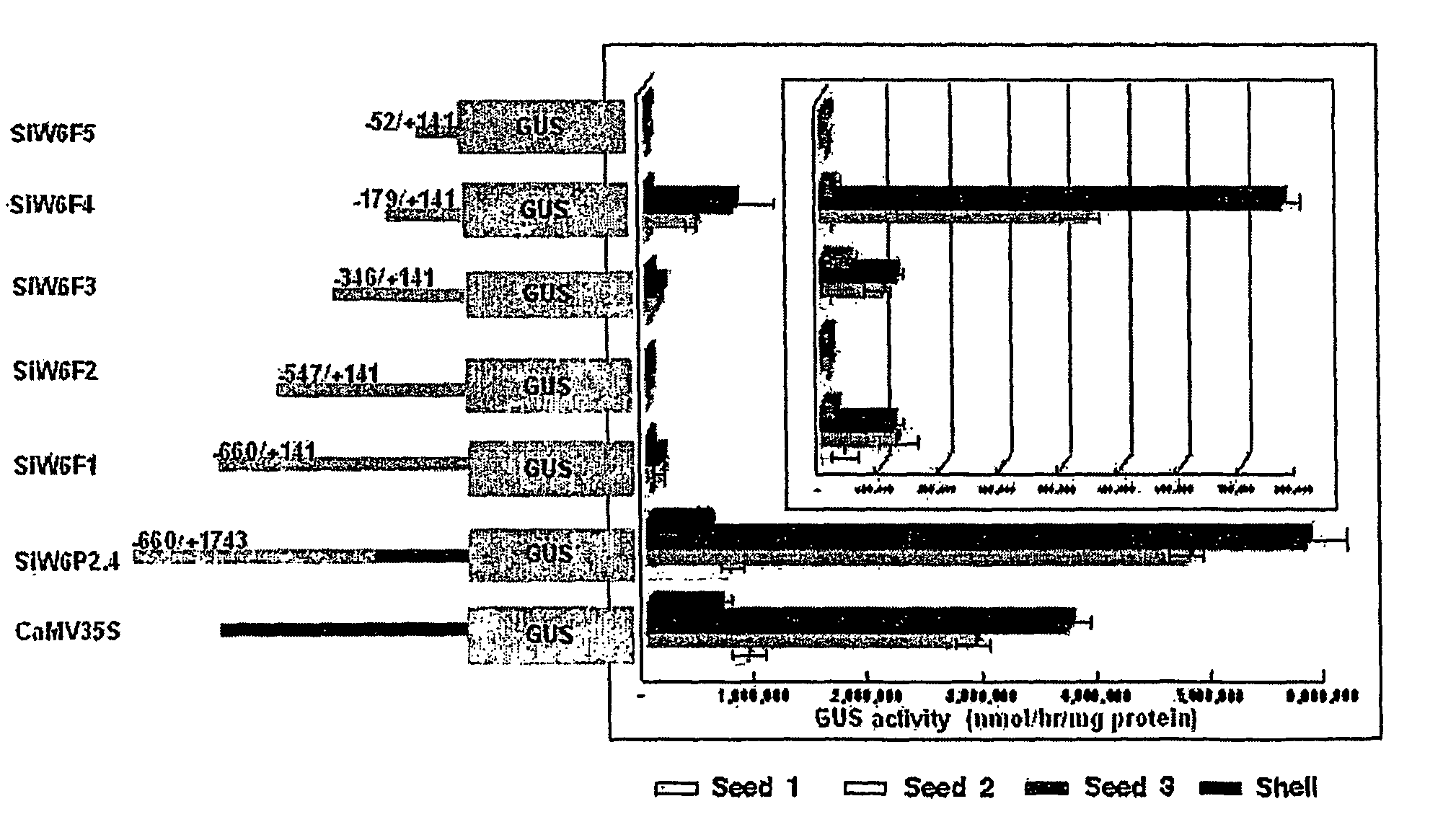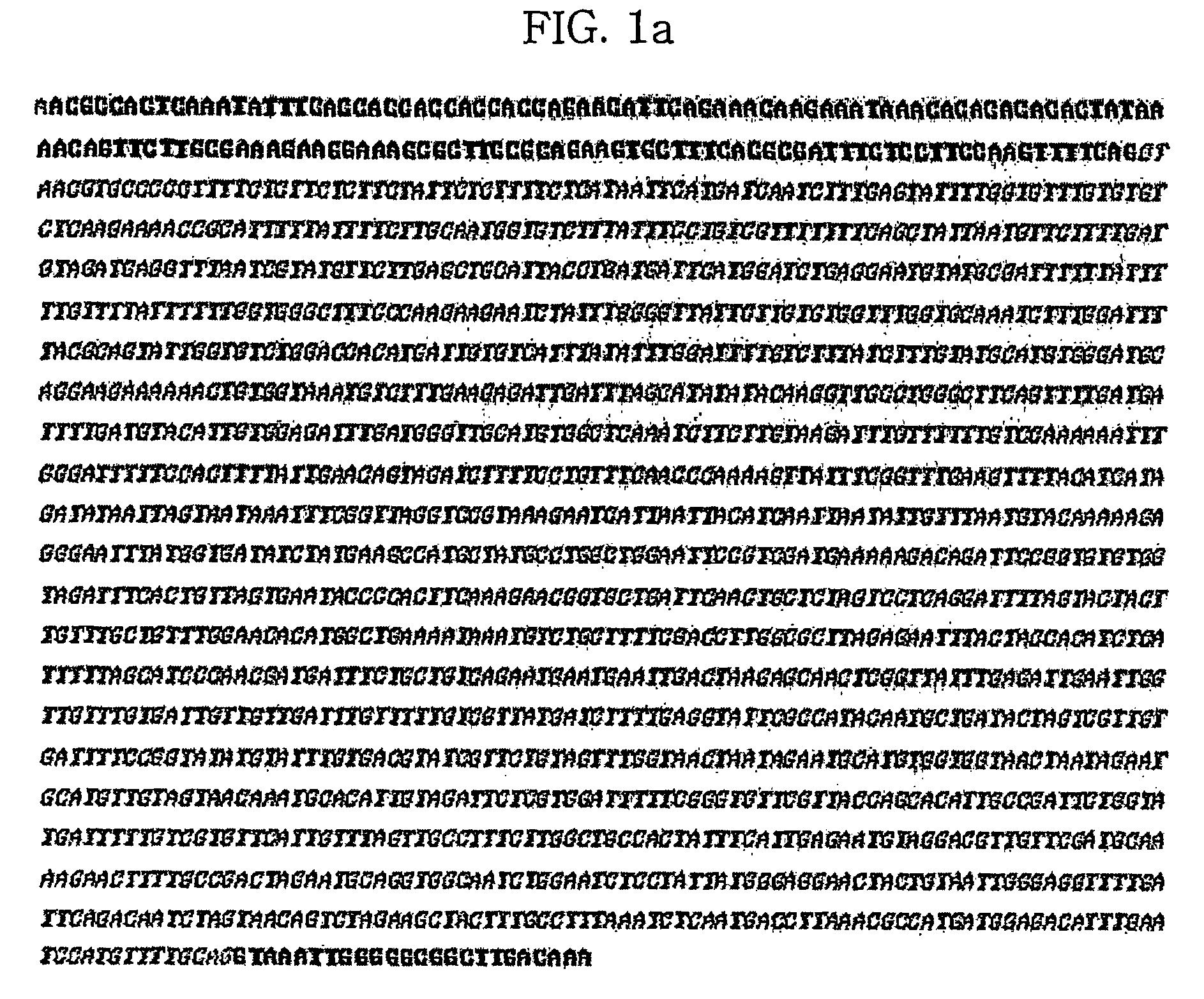Plant seed-specific expression promoter derived from sesame and seed-specific expression vector comprising the promoter
a technology of plant seed and promoter, which is applied in the field of plant seed-specific expression promoter, can solve the problem that the promoter cannot induce seed-specific gene expression, and achieve the effect of increasing the expression level of a foreign gene in a seed and high expression of a foreign gen
- Summary
- Abstract
- Description
- Claims
- Application Information
AI Technical Summary
Benefits of technology
Problems solved by technology
Method used
Image
Examples
example 1
Cloning and Sequencing of Genomic Gene Encoding Sesame Microsomal Oleic Acid Desaturase (Si-FAD2)
[0046]In order to obtain genomic clones of seed-specific Si-FAD2 gene, genomic DNA was extracted from young leaves of Sesamum indium [Dellaporta et al., 1984, in Molecular Biology of Plants]. The genomic clones of the Si-FAD2 gene were isolated by polymerase chain reaction (PCR) using a pair of primers (forward primer W6-1: 5′-GACAAAATGGGAGCCGGAGGACGCATGT-3′ and reverse primer W6-R1: 5′-CGGCTTCAGAACTTGTTCTTGTACCAGA-3′) designed from cDNA (GenBank Accession No: AF192486) disclosed by Jin et al. [2001, Plant Science]. The genomic clones thus isolated were cloned into a pGEM-T vector (Promega, America) followed by sequencing using ABI Bigdye cycle sequencing kit (PE Applied Biosystems, America). In comparison between the genomic clones and the cDNA, it was demonstrated that the genomic clones and the cDNA were identical except 9 bases (CGGCACGAG) from the 5′-end of the cDNA. The genomic clo...
example 2
Sequencing of 5′-Upstream Region of Si-FAD2 Gene
[0047]In order to clone the promoter of the Si-FAD2 gene, inverse PCR was performed using the genomic DNA of the Si-FAD2 gene digested with NdeI restriction site. Generally, inverse PCR has been frequently used in detection of unknown regions such as a promoter [Digeon et al., 1999, Plant Molecular Biology]. For inverse PCR, the genomic DNA was digested with NdeI restriction enzyme and self-ligated by T4 DNA ligase (BM, Germany) to prepare a template DNA. Inverse PCR was performed in two steps to obtain specific PCR products. First, the first PCR was performed using gene-specific primers (W6-1: 5′-GACAAAATGGGAGCCGGAGGACGCATGT-3′ and W6-R6: 5′-GGGGGCACGTTACCTGAAAACTTGGAAG-3′) to obtain a first PCR product. Then, the second PCR was performed using the first PCR product as a template with inner primers (W6-2: 5′-GGCTTTGGGACGAAGACTTCGTCACGCT-3′ and W6-R7: 5′-CGCGTGAAAGCACTTCTGCGGAAGCGC-3′). As a result, the 5′-upstream region (about 750 bp...
example 3
Identification of Transcription Initiation Site of Si-FAD2 Gene
[0049]In order to determine the activity of the seed-specific promoter of the Si-FAD2 gene, the transcription initiation site of the gene must be identified. For this, cRACE (circular first-strand cDNA-mediated rapid amplification of cDNA ends) was performed according to Maruyama et al method [Nucleic Acid Research, 1995]. First, total RNA was isolated from sesame seeds. Then, cDNA was synthesized with a gene-specific primer (5′-GGTAGCAGTATGGGGATGGCAGCAGATGGAAGTA) which was phosphorylated by T4 polynucleotide kinase (Takara) and reverse transcriptase (BM), and the 5′- and 3′-ends of the cDNA were ligated with T4 RNA ligase (NEB). PCR was performed using the resultant cDNA as a template with gene-specific primers (W6-5: 5′-GAAGAACCCCCTCCAACGGGTGCC-3′ and W6-R9: 5′-CCGATCACATCGCAAGTGCGATACACCTG-3′). As a result, it was demonstrated that the first base “A” of FIG. 1 is a transcription initiation base.
PUM
| Property | Measurement | Unit |
|---|---|---|
| pH | aaaaa | aaaaa |
| acid desaturase | aaaaa | aaaaa |
| electrophoretic photograph | aaaaa | aaaaa |
Abstract
Description
Claims
Application Information
 Login to View More
Login to View More - R&D
- Intellectual Property
- Life Sciences
- Materials
- Tech Scout
- Unparalleled Data Quality
- Higher Quality Content
- 60% Fewer Hallucinations
Browse by: Latest US Patents, China's latest patents, Technical Efficacy Thesaurus, Application Domain, Technology Topic, Popular Technical Reports.
© 2025 PatSnap. All rights reserved.Legal|Privacy policy|Modern Slavery Act Transparency Statement|Sitemap|About US| Contact US: help@patsnap.com



